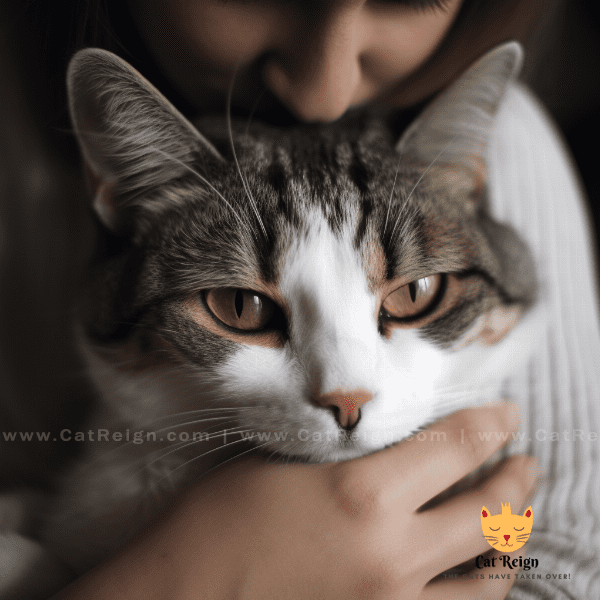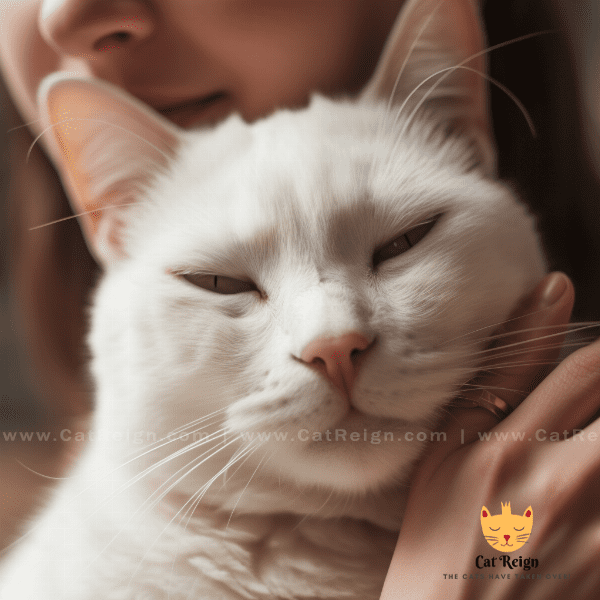Table of Contents
- The Mystery of a Silent Feline
- Causes of Cat’s Lost Voice
- Signs and Symptoms to Look For
- When to Visit the Vet
- Home Remedies for a Hoarse Cat
- Helping Your Cat Through the Recovery Process
- Preventing Lost Voice in Cats
- Understanding Feline Communication
- Coping with a Mute Cat
- Finding Comfort in Other Ways.
The Mystery of a Silent Feline
Cats are known for their vocalizations, from meows and purrs to hisses and growls. So, when a cat suddenly goes silent, it can be quite concerning. The loss of a cat’s meow can occur for several reasons, and it’s essential to understand the underlying cause to provide the proper treatment.
Possible Causes of Lost Voice in Cats
One of the most common reasons a cat might lose its meow is due to an upper respiratory infection. This type of infection can cause inflammation and swelling in the larynx and vocal cords, making it difficult for a cat to vocalize. Another common cause of lost voice is trauma to the throat or neck. This can occur if a cat is involved in a fight or falls from a high place. In some cases, a tumor or growth in the throat can also lead to a cat’s lost voice.
Symptoms to Look For
When a cat loses its meow, it’s usually the first sign that something is wrong. Other symptoms to look for include difficulty swallowing, coughing, and gagging. Cats may also exhibit signs of lethargy and loss of appetite, depending on the underlying cause.
Seeking Veterinary Care
If your cat has lost its voice, it’s essential to seek veterinary care promptly. The vet will examine your cat’s throat and neck to determine the underlying cause of the lost voice. They may also order additional tests, such as blood work or X-rays, to help make a diagnosis.
Treatment Options
The treatment for a lost voice in cats will depend on the underlying cause. If the cause is an upper respiratory infection, your vet may prescribe antibiotics or antiviral medications. If the cause is trauma to the throat or neck, your cat may need surgery to repair any damage. In cases where a tumor or growth is present, surgical removal or radiation therapy may be necessary.
In conclusion, a lost voice in a cat can be a sign of an underlying health issue, and it’s essential to seek veterinary care if you notice any changes in your cat’s vocalization. By understanding the possible causes, symptoms to look for, and treatment options available, you can provide your feline friend with the care they need to recover their meow.

Causes of Cat’s Lost Voice
There are several reasons why a cat might lose its voice. Some of the most common causes have been discussed above, but let’s take a closer look at each of them.
Upper Respiratory Infections
Upper respiratory infections are one of the most common causes of lost voice in cats. These infections are often caused by viruses, such as the feline herpes virus or calicivirus. Bacteria can also be responsible for respiratory infections. In addition to lost voice, other symptoms of an upper respiratory infection include coughing, sneezing, nasal discharge, and fever.
Trauma to the Throat or Neck
Trauma to the throat or neck can occur due to a variety of reasons. It could be a result of a fall or an accident, such as being hit by a car. Cats that engage in fights with other animals can also suffer from trauma to the throat or neck. Symptoms of trauma to the throat or neck include difficulty breathing, swallowing, and vocalizing.
Tumors or Growths
Although rare, tumors or growths in the throat or neck can also cause a cat to lose its voice. These growths can be either benign or malignant and can occur anywhere in the throat, from the larynx to the vocal cords. Cats with tumors or growths may exhibit symptoms such as coughing, weight loss, and difficulty eating or drinking.
Other Causes
Other less common causes of lost voice in cats include neurological conditions, such as laryngeal paralysis, and congenital defects. These conditions can affect the nerves and muscles that control the vocal cords, resulting in a loss of voice.
In summary, a lost voice in a cat can be caused by several factors, including upper respiratory infections, trauma to the throat or neck, tumors or growths, and other underlying health conditions. It’s crucial to seek veterinary care if you notice any changes in your cat’s vocalization to determine the underlying cause and provide appropriate treatment.
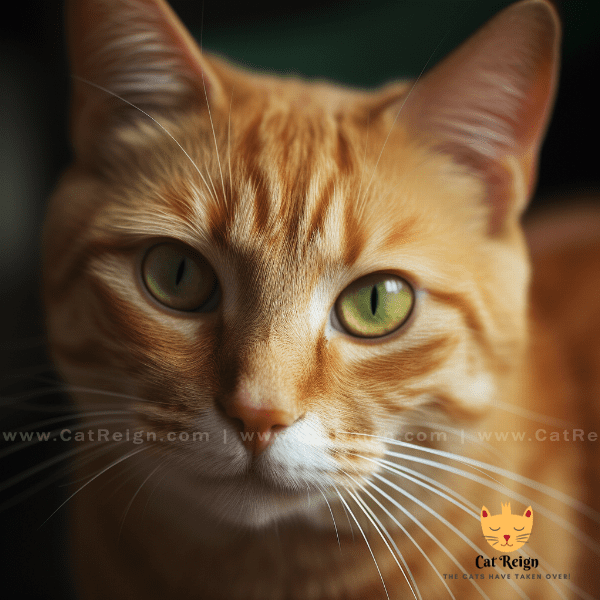
Signs and Symptoms to Look For
If you suspect that your cat has lost its voice, it’s essential to look for other signs and symptoms that may indicate an underlying health issue. Here are some signs and symptoms to be aware of:
Changes in Vocalization
The most obvious sign that your cat has lost its voice is a change in vocalization. Instead of meowing or purring, your cat may produce only a faint or raspy sound, or they may be entirely silent.
Difficulty Swallowing
Cats with lost voice may also experience difficulty swallowing. They may take longer to eat or drink or may appear to be in pain while swallowing.
Coughing and Gagging
Cats with upper respiratory infections or trauma to the throat or neck may experience coughing or gagging. These symptoms may be accompanied by sneezing or nasal discharge.
Lethargy
Cats that are unwell may exhibit signs of lethargy, such as sleeping more than usual or appearing disinterested in their surroundings.
Loss of Appetite
A loss of appetite is another common sign that something is wrong with your cat. If your cat is not eating or drinking as much as usual, it could be a sign of an underlying health issue.
Fever
Cats with infections or other health issues may develop a fever. If your cat’s body temperature is higher than normal, it’s essential to seek veterinary care.
In conclusion, if your cat has lost its voice, it’s important to look for other signs and symptoms that may indicate an underlying health issue. Changes in vocalization, difficulty swallowing, coughing and gagging, lethargy, loss of appetite, and fever are all potential signs that something is wrong with your feline friend. If you notice any of these symptoms, it’s crucial to seek veterinary care promptly to provide your cat with the care they need.
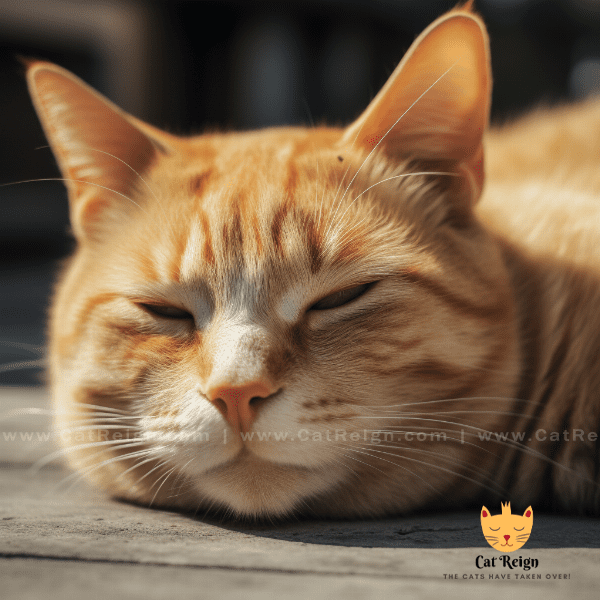
When to Visit the Vet
If you notice any changes in your cat’s vocalization or other signs and symptoms of an underlying health issue, it’s essential to seek veterinary care promptly. Here are some situations where you should schedule a visit with your vet:
Persistent Lost Voice
If your cat has lost its voice for more than a day or two, it’s crucial to seek veterinary care. While some cats may experience temporary hoarseness due to a minor illness or injury, persistent lost voice can indicate a more serious underlying condition.
Difficulty Swallowing or Breathing
Cats that are having difficulty swallowing or breathing require immediate veterinary attention. These symptoms can indicate a severe health issue, such as an obstruction in the throat or an allergic reaction.
Lethargy and Loss of Appetite
Cats that are exhibiting signs of lethargy or a loss of appetite for an extended period require veterinary care. These symptoms can be indicative of an underlying health issue, and your cat may require medication or other treatments to help them recover.
Other Signs and Symptoms
If your cat is exhibiting other signs and symptoms, such as coughing, gagging, fever, or nasal discharge, it’s essential to schedule a visit with your vet. These symptoms can be caused by a wide range of health issues, and your vet can help determine the underlying cause and provide appropriate treatment.
In conclusion, if you notice any signs or symptoms of an underlying health issue in your cat, it’s crucial to seek veterinary care promptly. Persistent lost voice, difficulty swallowing or breathing, lethargy and loss of appetite, and other signs and symptoms require immediate attention from a qualified veterinarian. By seeking prompt veterinary care, you can help your feline friend recover their meow and enjoy a happy, healthy life.
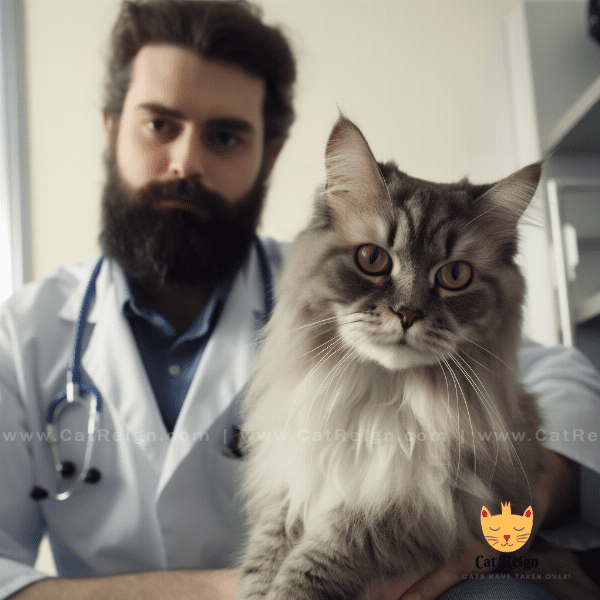
Home Remedies for a Hoarse Cat
While it’s always best to seek veterinary care for a hoarse cat, there are some home remedies that may help alleviate symptoms or promote healing. Here are a few options:
Humidifier
A humidifier can help moisten the air and soothe a cat’s throat. This can be especially helpful for cats with upper respiratory infections that are causing their lost voice. Place the humidifier in the room where your cat spends the most time.
Warm Compress
A warm compress can help alleviate inflammation and soothe a cat’s throat. Soak a clean cloth in warm water, wring it out, and apply it to your cat’s throat for several minutes at a time. Repeat as needed throughout the day.
Encourage Fluids
Encouraging your cat to drink plenty of fluids can help keep their throat moist and promote healing. Offer water and other fluids throughout the day, and consider adding some low-sodium chicken broth or tuna juice to their water bowl to make it more appealing.
Soft Foods
Soft, easy-to-swallow foods can be beneficial for cats with lost voice or difficulty swallowing. Consider feeding your cat wet food or blending their dry food with a bit of water to create a soft, soupy consistency.
Rest and Comfort
Rest and comfort are crucial for cats with lost voice or other health issues. Provide a quiet, comfortable space for your cat to rest and recover, away from loud noises or other stressors.
It’s important to note that while these home remedies may help alleviate symptoms, they are not a substitute for veterinary care. If your cat’s lost voice persists or is accompanied by other signs and symptoms, it’s crucial to seek veterinary attention promptly. Your vet can help determine the underlying cause of your cat’s lost voice and provide appropriate treatment to help them recover.

Helping Your Cat Through the Recovery Process
If your cat has lost its voice, it’s essential to provide them with the care and support they need to recover fully. Here are some tips for helping your cat through the recovery process:
Follow Your Vet’s Instructions
If your cat has received veterinary care for their lost voice, it’s crucial to follow your vet’s instructions carefully. This may include administering medication, providing a special diet, or limiting your cat’s activity.
Provide a Quiet and Comfortable Environment
Cats recovering from lost voice or other health issues need a quiet and comfortable environment to rest and recover. Provide a cozy bed or blanket, and limit exposure to loud noises or other stressors.
Encourage Fluids and Soft Foods
Encouraging your cat to drink plenty of fluids and eat soft, easy-to-swallow foods can help promote healing and prevent dehydration. Offer water and other fluids throughout the day, and consider feeding your cat wet food or blending their dry food with a bit of water to create a soft, soupy consistency.
Monitor Your Cat’s Symptoms
It’s essential to monitor your cat’s symptoms during the recovery process. If you notice any changes or new symptoms, it’s crucial to seek veterinary care promptly.
Provide Comfort and Affection
Providing comfort and affection can help reduce stress and anxiety for cats recovering from lost voice or other health issues. Spend time with your cat, pet them gently, and talk to them in a soothing voice.
Prevent Future Health Issues
Preventing future health issues is essential for ensuring your cat’s long-term health and well-being. Schedule regular check-ups with your vet, provide a healthy diet, and ensure your cat gets plenty of exercise and mental stimulation.
In conclusion, helping your cat through the recovery process requires patience, care, and attention. Following your vet’s instructions, providing a quiet and comfortable environment, encouraging fluids and soft foods, monitoring symptoms, providing comfort and affection, and preventing future health issues can all help your cat recover fully from lost voice and enjoy a happy, healthy life.
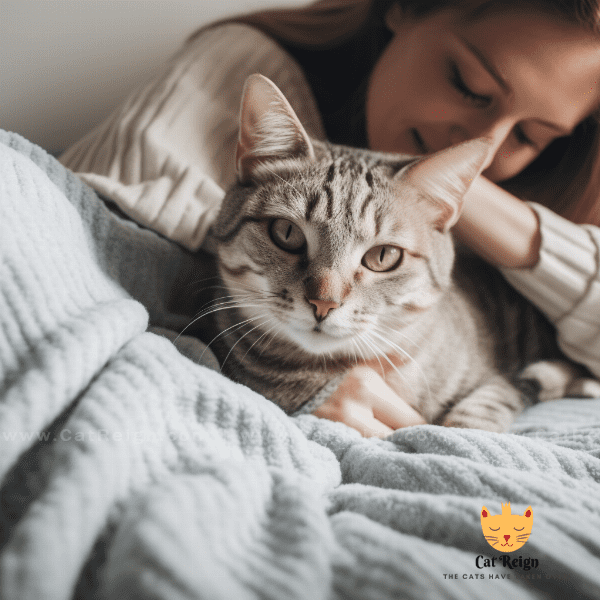
Preventing Lost Voice in Cats
While some causes of lost voice in cats, such as trauma or health conditions, may be difficult to prevent, there are some steps you can take to reduce the risk of your cat developing lost voice. Here are some tips for preventing lost voice in cats:
Prevent Upper Respiratory Infections
Upper respiratory infections are a common cause of lost voice in cats. You can help prevent these infections by keeping your cat up-to-date on vaccinations and avoiding contact with other sick animals. Regular veterinary check-ups can also help catch and treat infections early.
Reduce the Risk of Trauma
Trauma to the throat or neck can cause a cat to lose its voice. You can reduce the risk of trauma by keeping your cat indoors, away from potential dangers such as cars, dogs, or other animals. If you have multiple cats, ensure they get along well and separate them if they engage in aggressive behavior.
Provide a Healthy Diet
Providing your cat with a healthy, balanced diet can help boost their immune system and reduce the risk of health issues that can lead to lost voice. Talk to your vet about the best diet for your cat’s age and health needs.
Maintain Good Hygiene
Good hygiene can help prevent the spread of infections and reduce the risk of lost voice. Regularly clean your cat’s litter box, wash their food and water bowls, and groom them regularly to keep their coat and skin healthy.
Monitor Your Cat’s Health
Regularly monitoring your cat’s health can help catch and treat health issues before they lead to lost voice. Watch for signs of illness, such as changes in appetite, behavior, or vocalization, and seek veterinary care promptly if you notice anything unusual.
In conclusion, preventing lost voice in cats requires a combination of preventative measures, including vaccinations, reducing the risk of trauma, providing a healthy diet, maintaining good hygiene, and monitoring your cat’s health. By taking these steps, you can help ensure your cat stays healthy and happy, with a strong and healthy meow.

Understanding Feline Communication
Cats use a variety of vocalizations and body language to communicate with their humans and other animals. Understanding feline communication can help you better understand your cat’s needs and emotions. Here are some common feline communication methods:
Vocalizations
Cats use a variety of vocalizations to communicate, from meows and purrs to hisses and growls. Meows can indicate a range of emotions, from greeting to hunger or distress. Purring often indicates contentment or relaxation, while hissing and growling can be defensive or aggressive.
Body Language
Cats also use body language to communicate. A cat with an arched back and raised fur may be feeling threatened or defensive, while a relaxed, open posture indicates comfort and contentment. Tail position can also indicate a cat’s mood, with a tucked tail indicating fear or submission, and an upright tail indicating confidence or aggression.
Scent Marking
Cats use scent marking to communicate with other cats, leaving their scent through urine, feces, and scratching. Scent marking can indicate territory, social status, or mating readiness.
Visual Communication
Cats use visual cues to communicate as well, such as dilated pupils indicating excitement or fear, or slow blinking indicating contentment and trust.
Understanding Your Cat’s Communication
By paying attention to your cat’s vocalizations, body language, scent marking, and visual cues, you can better understand their needs and emotions. Knowing when your cat is feeling happy, relaxed, scared, or in need of attention can help you provide the care and support they need to thrive.
In conclusion, understanding feline communication requires paying attention to your cat’s vocalizations, body language, scent marking, and visual cues. By understanding these communication methods, you can better understand your cat’s needs and emotions and provide the care and support they need to be happy and healthy.

Coping with a Mute Cat
Having a mute cat can be challenging, as it can be difficult to understand their needs and emotions. Here are some tips for coping with a mute cat:
Pay Attention to Body Language
Since your cat can’t communicate through vocalizations, it’s crucial to pay attention to their body language. Watch for signs of comfort, such as a relaxed posture or slow blinking, and signs of stress or anxiety, such as a hunched posture or dilated pupils.
Experiment with Other Forms of Communication
While your cat may not be able to meow or purr, they may still respond to other forms of communication. Try using visual cues, such as pointing to their food bowl or toys, or using hand signals to indicate playtime or bedtime.
Be Patient
Cats with lost voice may require more patience and understanding than other cats. Be patient with your feline friend and take the time to understand their needs and emotions.
Provide a Comfortable Environment
A comfortable and stress-free environment is crucial for cats with lost voice. Provide a cozy bed or blanket, a quiet space away from loud noises or other stressors, and plenty of toys and activities to keep your cat entertained and stimulated.
Seek Veterinary Care
If your cat has lost its voice for an extended period or is exhibiting other signs and symptoms of an underlying health issue, it’s crucial to seek veterinary care promptly. Your vet can help determine the underlying cause of your cat’s lost voice and provide appropriate treatment.
In conclusion, coping with a mute cat requires patience, understanding, and a bit of creativity. Paying attention to your cat’s body language, experimenting with other forms of communication, providing a comfortable environment, and seeking veterinary care when necessary can all help you provide the care and support your mute cat needs to thrive.

Finding Comfort in Other Ways.
If your cat has lost its voice, there are other ways to provide them with comfort and affection. Here are some ways to find comfort in other ways:
Physical Touch
Physical touch, such as gentle petting and cuddling, can help soothe and comfort your cat. Be mindful of your cat’s body language and preferences, and respect their boundaries if they indicate they don’t want to be touched.
Playtime
Playtime can be a great way to bond with your cat and provide them with mental stimulation and exercise. Use toys that your cat enjoys, such as a laser pointer or catnip mouse, and engage in playtime regularly.
Grooming
Grooming your cat can help them feel clean and comfortable, and provide an opportunity for bonding and affection. Brush your cat’s fur regularly, trim their nails, and clean their ears and teeth as needed.
Music and Sound Therapy
Playing calming music or using sound therapy can help soothe and relax your cat. Look for music specifically designed for cats, or try playing nature sounds or classical music to create a calming atmosphere.
Massage
Massaging your cat can help relieve stress and tension, and provide them with physical and emotional comfort. Use gentle pressure and circular motions on your cat’s neck, back, and shoulders, and pay attention to their body language to ensure they’re enjoying the massage.
In conclusion, finding comfort in other ways can be a great way to bond with your cat and provide them with the love and care they need, even if they’ve lost their voice. Physical touch, playtime, grooming, music and sound therapy, and massage can all be great ways to provide comfort and affection to your feline friend.
